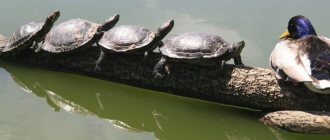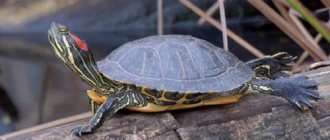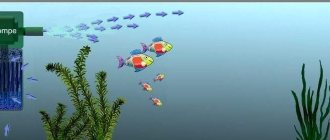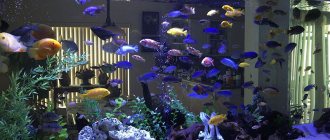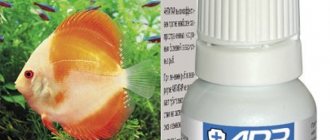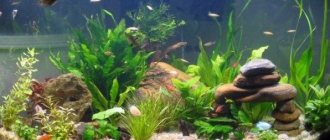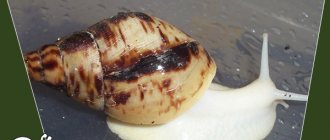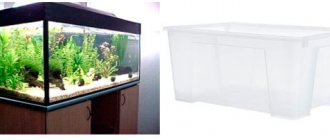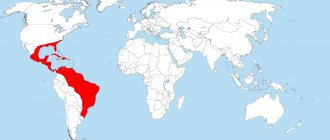General characteristics of fish
The name in Latin is Pterophyllum scalare. This unique and beautiful fish comes from South America. Its name translates as “leaf”, which, in fact, is confirmed by the shape of the body: flat, tall, reminiscent of a leaf of an unusual tree. Elongated fins, similar to sails or wings, contributed to the fact that the angelfish was dubbed angels. Indeed, the appearance of this inhabitant of the middle water layers of the aquarium is very exotic and magical.
Aquarium angelfish fish have a significant variety of color variations and body mutations. The standard colors are shades of gray with an olive, silver or greenish tint; more interesting varieties of angelfish are marbled, black, leopard, koi, and veil forms.
Differences between male and female angelfish.
Males and females differ noticeably from each other when they reach the age of puberty. Females are more graceful, have a straight or sunken forehead, and during the spawning period the ovipositor is clearly visible. Males are larger and more massive, with a clearly visible fat deposit in the form of a bump on the forehead, and with wide, powerful fins. The behavior of different sexes is also different and is especially clearly manifested in already formed pairs.
We breed angelfish in a community aquarium at home
How to create proper conditions for reproduction in a freshwater environment
Angelfish should not breed in a community aquarium, as neighbors may eat their brood, which will cause severe stress for the breeders. Install a separate tank (spawning tank) with freshwater water of the required parameters. The recommended volume of spawning tank is 75-100 liters for one pair. In a cramped space, it will be inconvenient for fish to reproduce, or they will refuse to do so altogether. It is advisable that the aquarium be high, because all types of angelfish have a greater body height than length.
See how angelfish spawn in a community aquarium.
It is imperative to check the pH level of the water, if necessary creating conditions that correspond to natural conditions. In natural reservoirs, angelfish live in water that is softly hard and slightly acidic. The pH level in the general spawning tank should reach 5.0-8.5, no more. The ideal threshold is 6.5-6.9 pH. For spawning, it is necessary to ensure the quality of the water, although this species of fish is quite hardy and can tolerate a different range of conditions. If the aquarium cannot achieve the ideal pH state, a reverse osmosis filter or a deionization filter will come to the rescue - they are very effective in such cases.
Try not to use chemicals to change the pH level, as this option does not guarantee a successful result. In addition, chemicals change the alkalinity of water, its acidity. Fish are sensitive to sudden changes in the aquatic environment, which adversely affects their health. With sudden changes in hardness and acidity, angelfish may die.
Check the water temperature in the aquarium - ideally it should be 26-27 degrees Celsius. In natural reservoirs they reproduce when the temperature rises; they are accustomed to such an environment and it is useful for them. Breeding is unlikely to occur in cool water. Use a water thermometer to regulate these parameters.
In a spawning aquarium, you need to install a good filtration system with current. Make sure that the current is not too strong - although angelfish love it, it will drive the fry to exhaustion. A strong filter should not be used unless absolutely necessary. The best types of filters are gravel and sponge. With a moderate flow of water, the couple will be comfortable, and the newborn brood will not fall into the powerful flow of the filter. Once a week in the spawning tank you need to replace 20-30% of the water with fresh and clean water.
See how to use a simple device to adjust the air supply to the aquarium filter.
Feeding
Recommendations
- It is not recommended to carry out sudden changes in temperature in the spawning aquarium. First let it match those in the common tank. Sudden changes cause shock, illness and even death. Increase the temperature gradually, by 1-2 degrees over several days.
- If you do not have a formed pair of angelfish, buy several ready-made pairs of fish, or 8-10 fish that will form pairs in a common aquarium and will reproduce in the future.
- If the fish are not breeding, try different ways to stimulate spawning. Raising the water temperature, moving to a larger tank, installing the necessary decor (stones, plants), replacing water, and feeding with live food can solve the problem of missing spawning.
AkvariumnyeRybki.ru>
Story
The angelfish got its name from the light hand of a zoologist from Austria I.Ya. Heckel in 1840. “Leaf with wings” (literal translation of the name from Latin) had already been described several times by scientists and experts.
After its first appearance in Europe, they tried to import angelfish for a long time and unsuccessfully, but the fish died along the way. For the first time, luck accompanied G.B. Sagratski, who brought live specimens from the Rio Negro, christening them “Blattfische” (in the future this name did not catch on and was changed).
A certain value of angelfish at that time also lay in the fact that almost no one was able to reproduce them. The first known case was recorded only in 1914 in Hamburg. The next lucky guy was an American who took a whole year to reproduce the natural conditions for fish breeding in an aquarium. And in 1920, the period of mass scalar breeding began.
By 1928, the matter had reached Russia through the efforts and efforts of A. Smirnov, although the result was achieved due to the confluence of a number of random circumstances. In his absence, the water temperature of the fish changed significantly by 4 degrees and reached 32, which was sufficient for the angelfish to begin the spawning process.
Origin of the angelfish
The cichlid family includes not only fish with a torpedo-shaped body, but also delicate and very attractive ones, which for many years were very rare and expensive because they did not breed easily in aquariums. Pterophyllum scalare almost disappeared , because even experienced aquarists have never been able to propagate this species in an aquarium. But a smaller one remained - Pterophyllum eimekei , which reproduced more easily, as well as hybrids of these two species. For the first time, fry were obtained in Europe only in the early 20s of the last century, and in our country in 1928. And only 20 years later, angelfish began to be bred in large quantities. Now the small species is not uncommon in the aquarium and reproduces easily.
Maintenance and care
Keeping angelfish in an aquarium is not difficult. It is only important to remember a few rules related to their historical origin, namely the climatic characteristics of their natural habitat.
For a comfortable life, the angelfish must maintain the temperature in the aquarium within 23 - 26 degrees, the water must be soft.
Angelfish love dense thickets, but do not forget to leave room for them to swim.
"Angels" are among the cichlids. In the clear waters of the Amazon, fish have adapted to hide in thick algae to survive. At home, this requirement must also be met - a significant number of plants will ensure the usual living conditions and the realization of innate instincts.
These fish are active and moderately mobile. They require sufficient space. The lower limit of the volume of an aquarium for keeping angelfish is 80 - 100 liters; a volume of at least 250 liters is considered optimal.
It has been proven and tested that the greater the amount of water, the larger the individuals.
It is important to observe the following conditions for keeping angelfish in an aquarium:
- Partial replacement of a quarter of the total volume of water must be done every week.
- Requires shaded areas and medium light intensity. Bright light can frighten and unnerve fish. This is why it is recommended to use aquatic plants to create a natural environment.
- Proper design of space plays an important role. The presence of a variety of hiding places in the aquarium is not necessary, but an open place for swimming is vital.
Video: Angelfish in an aquarium
Over the long period of time when these fish inhabit aquariums, angelfish are so accustomed to different conditions that they adapt to almost any temperature and chemical composition of water . As practice has shown, it is possible to grow good individuals at 16 -17 degrees or in hard water.
It should be noted that the most unfavorable factor for the care and maintenance of angelfish is the presence of frequent sharp jumps in water parameters: they must remain unchanged.
Difficult living conditions affect the color intensity of these representatives of cichlids. The body becomes faded, the stripes are practically invisible. The charm and shine of the fish is lost. This applies to absolutely all characteristics. This result can be obtained both with a violation of light intensity and with an unbalanced diet.
Compliance with the stated instructions is extremely important so that the care and maintenance of angelfish creates a minimum amount of difficulties, especially for beginners.
How to feed?
The feeding schedule is important so that angelfish do not feel hungry and at the same time do not overeat. This is due to the fact that a large amount of food is detrimental to the fish’s excessively small stomach. Overfeeding leads to a variety of digestive disorders and can even result in the death of the “wards”. If the fish is constantly malnourished, then a degenerative process may begin, so it is important to dose the food. As for the feeding schedule, it should be as follows:
- to feed the fry, you need to give them food 3 times a day; at about 3 months, young fish are transferred to two meals a day;
- in the future, adult individuals eat 2 or 1 time a day, it all depends on their size and appetite, but it is important that they eat the food within 2–3 minutes;
- Dry and live food must be alternated with herbal supplements, the main thing is that the animals in your care do not overeat; to do this, they should have a fasting day once a week, that is, not feed them at all.
In terms of feeding newborn babies, you should start with ciliates and boiled yolk - this is the best food for them, from which they quickly develop and grow. The boiled product is kept in the freezer, when it’s time to eat, take it out, break off a piece and run a brush over it, which is rinsed in a jar of water.
Then they wait until the yolk particles settle, drain the water and add fresh water, as a result it should get rid of the turbidity and become clean. Then the remaining particles and a small amount of water are poured onto the compressor bubbles, and the fry eat them until they settle to the bottom.
Since the yolk can pollute the water, caring for the fry consists of constantly purifying the water; by the way, ampularia - snails, which will perfectly clean the bottom, can help with this. In addition to “live dust” and eggs, you can also buy special dry mixtures for fry, and after a week the fry are transferred to branchial crustaceans - artemia.
High-quality nutrition is an important aspect of keeping angelfish, allowing you to maintain the health of the fish and increase their lifespan up to 10 years.
Other interesting articles
- What to feed crucian carp at home in an aquarium Crucian carp, perch, roach and ruffe are fish designed to exist in natural bodies of water. However, with…
- How to feed snails at home in an aquarium Many aquarium owners get snails without knowing at all whether they are compatible with other inhabitants of the aquarium...
- How long do catfish live in an aquarium at home? The aquarium catfish is not just an unusual fish whose behavior is very interesting to observe, but also...
Feeding
Angelfish are not the most picky when choosing food. They feed well on dry or live food, as well as their substitutes. Of course, the fish give preference to coretra, bloodworms, cyclops and others. The “angel” is accustomed to feeding near the surface of the water. Residues of food may remain at the bottom.
When caring for angelfish in an aquarium, you should remember that sometimes they refuse to eat for a fairly long period of time, which lasts up to 14 days. This is a normal behavioral sign.
You can also use store-bought food as your main food, but don’t forget to pamper your pets and diversify their diet.
Like any living organism, fish require a varied, and most importantly, balanced diet. Because of this, novice aquarists prefer to use dry food. The only thing to remember is that the diet should not be monotonous, so it is advisable to add the same daphnia in dried form .
“Angels” like to add variety to their menu by adding plant foods. If you see bitten algae, you need to include spirulina in the feeding system. You should also pay attention to the “bitten” neighbors in the aquarium. In this case, it is necessary to increase the amount of animal protein in the diet.
What food does the angelfish prefer?
Fish readily eat any live food, which is especially useful during the period when angelfish spawn. However, this type of feeding has three significant disadvantages:
- it is not always on sale;
- may be spoiled;
- often causes infections.
The microorganisms that fish like to eat include:
- amphibian and mosquito larvae;
- copepods and small planktonic crustaceans;
- coretras – larvae of non-blood-sucking mosquitoes;
- tubifex - oligochaete thread-like worms;
- Mormysh are freshwater amphipods belonging to the arthropod family.
But these angelfish “dishes” cannot be served in their natural form - the food is first frozen or purchased already frozen, with the exception of the tubifex, since after freezing the bodies of crustaceans turn into a solid mess. Feeding fish with bloodworms caught on your own is also dangerous, since there is always a risk of infectious infection.
You can purchase mormysh in specialized stores for fishermen and freeze it yourself. First, the crustaceans are heat-treated in the microwave (for 2 minutes), after they turn red, they are placed in the freezer. Before giving food to the fish, it must be thawed and kept at room temperature for some time (food should not be given cold).
Mormysh is more suitable for large specimens, but it is better not to feed the dried product (as well as daphnia) to your pets. This is the opinion of experienced aquarists, who believe that there is nothing useful in them for ornamental fish.
Behavior and character
Proper care of angelfish involves not only creating comfort at the physical level, but also taking into account the specifics of their behavior and character.
Keeping an entire flock-family is considered optimal. This will allow the fish to establish their own hierarchy of pairs, where the stronger and more aggressive partners will be at the head.
It is interesting to note that the number of fish in the group must be even.
In general, angelfish are non-aggressive species. However, this may change if the zonal division of the aquarium is disrupted. A strict balance between dense thickets and open space is required.
It doesn’t hurt to remember that these fish are cichlids, which means they won’t miss the opportunity to chase weaker ones, pluck veil fins and tails, and profit from small inhabitants of the aquarium and fry.
Compatibility table for angelfish with other types of aquarium fish.
Despite this, angelfish get along well with those fish that prefer to be in the upper and/or lower layers of water. For example, catfish, representatives of labyrinthids (cockerels, gouramis, macropods), will be good neighbors.
It is strictly not recommended to keep these cichlids with the following types of fish:
- neons;
- guppy;
- discus;
- cardinals;
- goldfish;
- with viviparous (due to eating fry).
Compatibility of angelfish with other fish
When thinking about the compatibility of angelfish, remember a few main factors of their content:
- Angelfish are cichlids. These are predators
- Angelfish are territorial fish
- Angelfish have long fins
- Angelfish love clean water
Angelfish are capable of eating or killing any small aquarium fish that does not have sufficient movement speed. This circumstance makes it difficult to keep angelfish together with guppies or neons.
Pairs of angelfish occupy different corners of the aquarium in accordance with the hierarchy within the school. All other fish will be driven away, making it difficult to keep angelfish with other territorial fish, such as gouramis. Especially at the time of spawning or nest building.
The long fins of angelfish can be stripped by fish such as barbs or other tail strippers. The requirement for clean water does not allow keeping angelfish together with goldfish, which actively dig the soil.
To summarize, we can name fish that are ideally compatible with angelfish:
- Catfish
- Danio
- Discus
- Mollies
- Rasbory
- Tetras
You can try keeping barbs and cockerels in the same aquarium with angelfish.
Reproduction
Angelfish are monogamous fish and in most cases create pairs on their own. But you can intervene in this process. To do this, it is enough to select a male and female that are close in age and size, and put them in a separate aquarium. After some time, a pair will be created. You can find out about this by carefully observing their behavior: the fish stick together and swim after each other.
Video: Spawning angelfish
Subject to optimal conditions for keeping and caring for angelfish, the frequency of spawning can be 14 days. A mandatory requirement is the immediate removal of eggs from the aquarium .
For productive spawning, during the period of preparation for it, the couple must constantly be together. Only then do the males develop high-quality reproductive products.
Stimulation of spawning is achieved by increasing the temperature by 4 - 6 degrees (up to 32), frequent changes of water (it is better to use boiled or distilled), and the presence of large-leaved plants. As a rule, the process of laying eggs takes place in a common aquarium; separate spawning of the pair is not required.
Angelfish are incredibly beautiful and interesting in behavior aquarium fish. No wonder she was nicknamed “angel”. The conditions of detention and care for her seem difficult only at first glance. For the opportunity to observe such exotic things every day at home, you can work a little - the result will exceed all expectations.
Self-prepared meals
Don't forget about meat feed for angelfish. This includes pureed shrimp meat, beef heart, minced meat with additives.
There are two cooking options.
First option
Beef heart is very easy to prepare.
All fat is washed off and washed well. Then the piece is rubbed on a medium-sized grater. The resulting mass is washed again and sent to feed the angelfish.
Second option
100 grams of beef heart is ground in a meat grinder or blender.
You can use a grater for these purposes. Grated cabbage, dried nettle leaves, and red bell pepper are added to the mixture. Additional ingredients are taken in equal proportions with minced beef. A raw egg is added to the mixture. The mass is laid out on a plate and baked in the microwave. Approximate time 1.5-2 minutes, depending on the power of the equipment. The resulting cake is cooled, packaged and the finished food is sent to the refrigerator.
After proper freezing, the product should crumble, but you need to track and knead large pieces. If the food size is too large, the fish will simply refuse it or choke.
